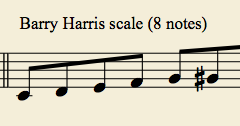
Barry Harris Jazz Workshop Pdf Reader
Barry Harris Rhythm Changes Transcription Lesson. Sony sound forge 10 vocal eraser plug in. Barry is truly a master at starting his jazz lines on different beats. He can take classic bebop licks that everybody plays and start them in unusual places. When you study a master like Barry Harris or any jazz transcriptions pdf. Nov 12, 2012 Barry Harris Method. I attended the Stanford Jazz Workshop--a week-long, all-ages summer 'camp.' The 'Harris Method' is structured more explicitly around bop practice and focuses on creating smooth chromatic melodies through the use of certain 'rules' (for example, descending from the tonic, 3rd, 5th or 7th of a major scale.
I thought it was time to gather up some of the Barry Harris stuff that is spread out all over the place. Are there any free resources that start from zero?
Not necessarily a full-on course, but maybe an overview?Not free, but there's a 26 page pdf available for $15 through Barry's site that gives a good overview with plenty to get you started: On the chordal side of things, the late Rick Stone had a couple of articles on the sixth diminished scales in Just Jazz Guitar magazine. At one time they were freely available from his website but the only place I can find them now is on Scribd (which I'm loathe to link to but it's the only obvious source for now): and Last edited by David B; at 02:38 PM.
The 6th dim scale seems to be what people most commonly know a little bit about.  In the material I have, it is mentioned as a tool for single lines, but is primarily a harmonic device, e.g. One of my favorites is playing it in contrary motion while 'filling in' the middle voices as the outers spread. Sometimes it just seems like people learn the 6th dim scale and think that's all there is to it and everything else is based off that. The single note stuff is actually focused on mainly other stuff. Just wanted to put that out there.
In the material I have, it is mentioned as a tool for single lines, but is primarily a harmonic device, e.g. One of my favorites is playing it in contrary motion while 'filling in' the middle voices as the outers spread. Sometimes it just seems like people learn the 6th dim scale and think that's all there is to it and everything else is based off that. The single note stuff is actually focused on mainly other stuff. Just wanted to put that out there.

I want to work on an overview for you guys. I'll do a little at a time since I tend to start projects and not finish.this way I'll let least have contributed something. Scale practice or 'the ABC's' 1. The chord built on the 5th of a dominant chord (the ii in a ii-V-I) is referred to as the 'important minor' of that dominant chord. For single note soloing the important minor is ignored and a dominant scale (mixolydian) is played over the ii and V.
G7 dominant scale over Cm7-G7. A two bar phrase is created by playing a major or dominant scale from the tonic to 7th back down to the tonic. That's called playing the scale 'Up and down.' Scales should be practiced in 3rds: Do Mi Re Fa Mi Sol etc Starting a half step below each 3rd: Ti Do Mi Di Re Fa Ri Mi Sol etc In triads: Do Mi Sol Re Fa La Mi Sol Ti etc Triads with half step below first note, 4 note chords (arpeggios), 4 note chords with half step below first note. There are 3 important arpeggios to master inside and out in all inversions within the dominant scale: Built off the tonic, the 5th, and 7th. Start adding melodic leaps by use of pivoting. Just octave displacement.I don't think I need to explain that.